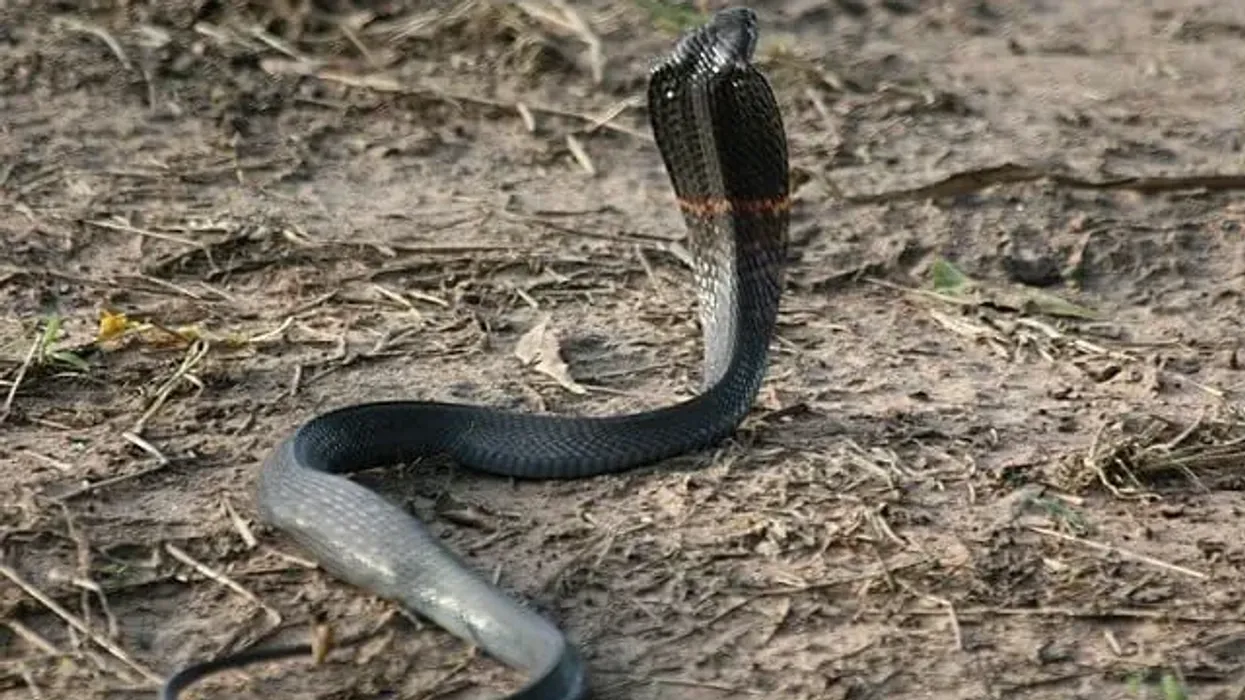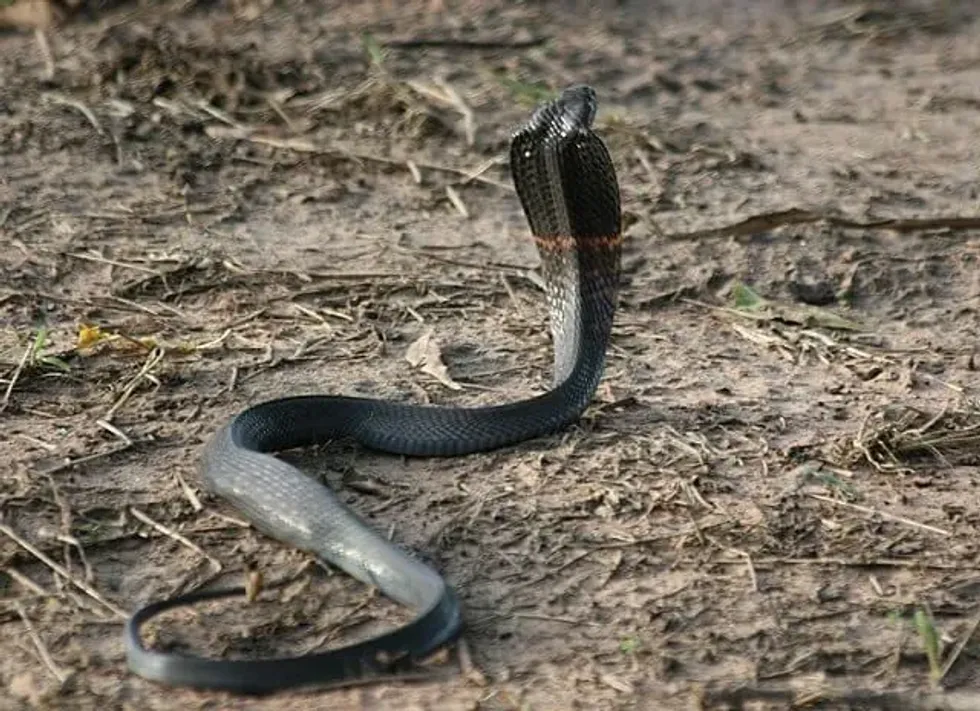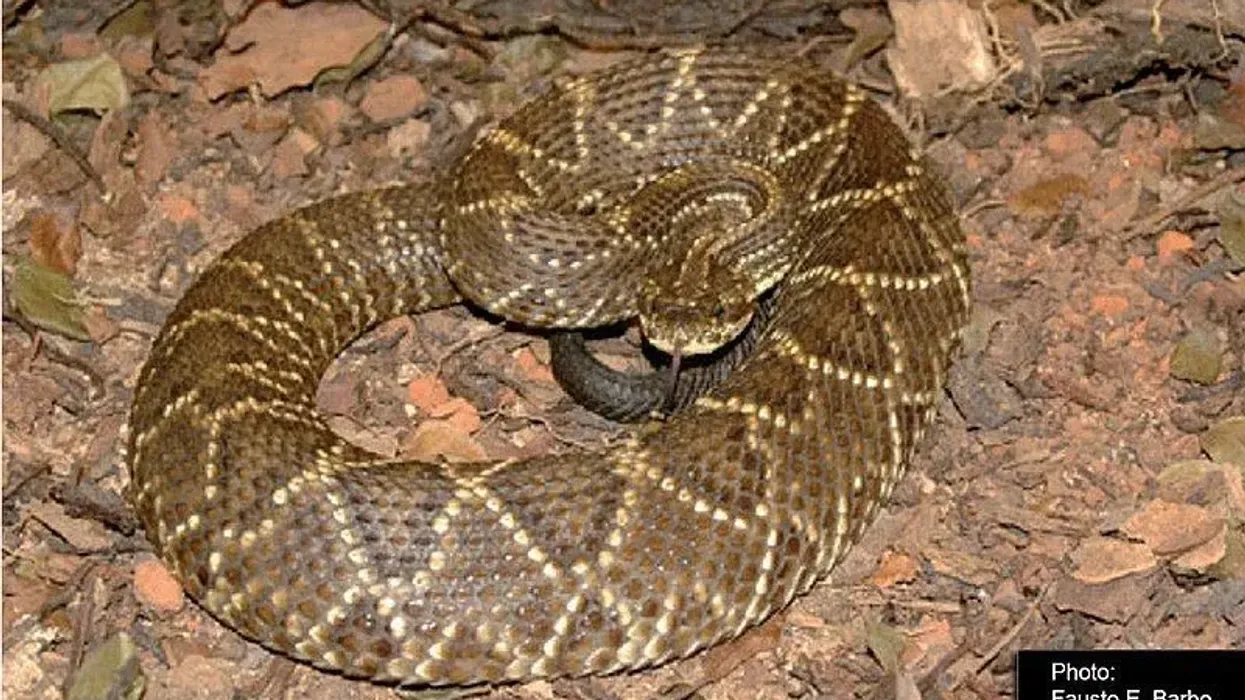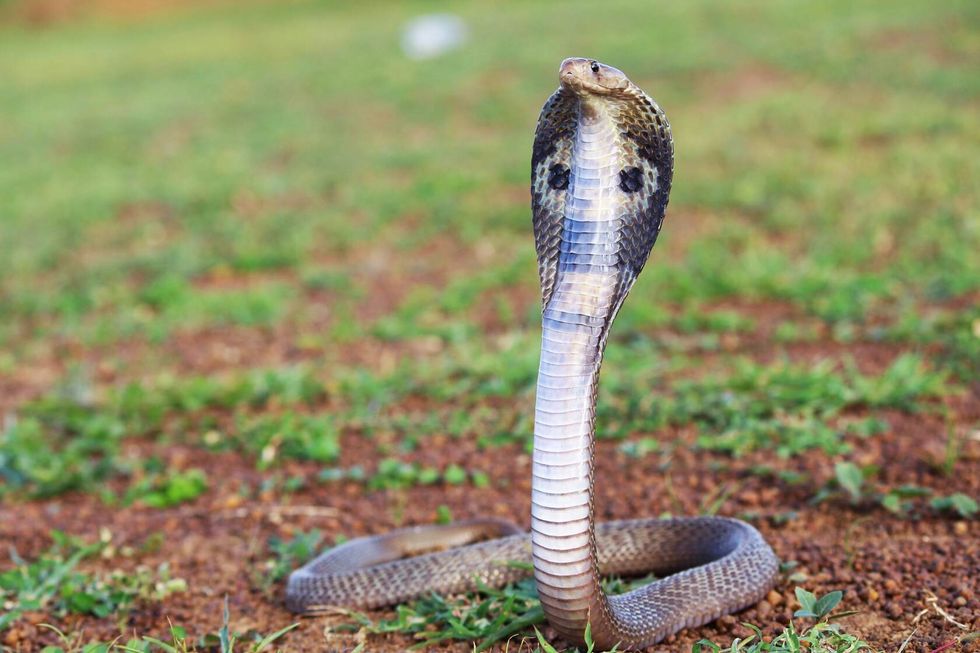If danger could have a physical form, it would unabashedly appear as the African black-necked spitting cobra!
A black-necked spitting cobra (scientific name: Naja nigricollis or N. nigricollis) is one of the ten species of African spitting cobras of the family Elapidae.
Mostly found in sub-Saharan Africa, N. nigricollis is notorious for its deadly venom, which is not only neurotoxic but highly cytotoxic and cardiotoxic as well. Like all other spitting cobras, the black-necked ones, too, have a remarkable ability to spit venom and bite even with a minor incitement.
A black-necked spitting cobra bite can wreak havoc with not just your nervous system but your cardiovascular system too!
The physical appearance of this cobra differs with the region of origin; while some specimens may be pale gray or black with a yellow or reddish ventral surface and a black neckband, others may be reddish-brown or yellowish-brown, with or without the neckbands.
An orange or pinkish bar on the neck is also common in several individuals. Unlike most other snakes, N. nigricollis may either be nocturnal or diurnal and can cover fairly large distances searching for food.
It can adapt itself according to the daytime temperature, geographic location, and time of the year that helps the snake better regulate its body temperature and maximize its access to the food resources of a particular habitat.
Find the Naja nigricollis interesting? Then read on to know more about this venomous reptile!
If you like black-necked cobra facts, do check out interesting and fun facts about the Mozambique spitting cobra and cobra.
Black-Necked Spitting Cobra Interesting Facts
What type of animal is a black-necked spitting cobra?
A black-necked spitting cobra (Naja nigricollis) is a snake of the family Elapidae. It is one of the several species of spitting cobras found in Africa.
What class of animal does a black-necked spitting cobra belong to?
A black-necked spitting cobra (Naja nigricollis) is a venom-producing reptile belonging to class Reptilia.
How many black-necked spitting cobras are there in the world?
No information is available regarding the total population size of black-necked spitting cobras (Naja nigricollis).
Where does a black-necked spitting cobra live?
Black-necked spitting cobras (Naja nigricollis) usually avoid dense forests.
They are common in the tropical and sub-tropical semi-desert regions, savannahs, and cleared former forests near rivers and streams. Black-necked cobras are predominantly distributed throughout much of sub-Saharan Africa, including central, eastern, western, and parts of southern Africa.
Except for the rainforest areas of the Congo Basin, the snake has been reported from Benin, Angola, Cameroon, Burkina Faso, Chad, Central African Republic, Democratic Republic of Congo, Gabon, Ethiopia, Guinea Bissau, Ghana, Kenya, Ivory Coast, Mali, Liberia, Nigeria, Niger, Sierra Leone, Senegal, Mauritania, Gambia, Tanzania, Sudan, Togo, Somalia, Zambia, and Uganda.
What is a black-necked spitting cobra's habitat?
Naja nigricollis is a highly adaptable snake species. It prefers tropical and sub-tropical habitats located near rivers and streams.
These snakes may look for deserted termite nests and rodent holes to hide or escape the scorching heat. Being proficient tree-climbers, these snakes often make trees a hideout spot besides using abandoned rodent holes to hide. The snake has also been reported from altitudes of 5,900 ft (1,800 m).
Who do black-necked spitting cobras live with?
Black-necked spitting cobras are primarily solitary reptiles. However, since these snakes are a common occurrence in Africa, they frequently come in direct contact with people in small towns and villages.
How long does a black-necked spitting cobra live?
A black-necked spitting cobra (Naja nigricollis) has an average lifespan of about 15-20 years. They have a longer lifespan than rat snakes, while pygmy rattlesnakes have similar longevity.
How do they reproduce?
Like most other reptiles, black-necked spitting cobras are oviparous, meaning that they lay eggs. The female usually lays about 10-15 eggs at a time, which may go up to 22 in number.
The gestation period stretches for about 90-100 days, and once the eggs are laid, they take around 60-70 days to hatch. The young snakes measure about 7.9-9.8 in (20-25 cm) long at birth and fend for themselves.
What is their conservation status?
The conservation status of black-necked spitting cobras has not been evaluated by the International Union for Conservation of Nature (IUCN) Red List of Threatened Species.
Black-Necked Spitting Cobra Fun Facts
What do black-necked spitting cobras look like?
Black-necked spitting cobra size and physical appearance vary with the geographic location of the particular specimen. These snakes are moderate in size with a prominent head; the peculiar bulging shape of the head is due to the presence of two large venom glands on either side of the head.
The body is covered with 21-23 scales on the upper part of the mid-body (dorsal scales), 182-196 scales on the underside of the body (ventral scales), and about 54-66 scales on the underside of the tail (subcaudal scales).
The skin color of the snakes specifically varies with the respective region of origin. Individuals with a pale gray or black body with yellow or reddish ventral sides, orange or pinkish bar on the neck, and a broad black neckband are quite common.
Others may be a deep shade of reddish-brown, yellowish-brown, or yellow copper.
The reddish color of the belly and the bands around the neck may or may not be present in all specimens. Some members have also been known to wear a completely white look with dark eyes (probably an albino black-necked spitting cobra) or may have black and white stripes.

How cute are they?
Black-necked cobras, or any venom-producing snake for that matter, are not conventionally regarded as cute due to the sheer fearsome reputation they have.
How do they communicate?
Snakes, in general, are not quite social creatures and do not really communicate much with each other, except, of course, during breeding. Like most cobras and other snake species, black-necked spitting cobras have a well-developed vomeronasal system that helps the animals in detecting chemical cues from potential prey and predators.
At the core of the vomeronasal system is the Jacobson's Organ located in the roof of the mouth. The organ is specialized to collect chemical signals from the environment via the snake's forked tongue that they are often seen flicking.
In addition, pheromones usually help the snakes to find a mating partner. If threatened, these snakes retaliate by spreading their hood and spitting (squirting) venom at the attacker.
How big is a black-necked spitting cobra?
Black-necked spitting cobras range in length between 3.9-7.2 ft (1.2-2.2 m). They are bigger than the Naja nigricincta, another species of spitting cobra with two subspecies. In comparison, Gaboon vipers are similar in size to some of the smaller specimens of this species.
How fast can a black-necked spitting cobra move?
The exact moving speed of the black-necked spitting cobras is not available.
How much does a black-necked spitting cobra weigh?
The specific weight range of black-necked spitting cobras is not available.
What are the male and female names of the species?
Male and female snakes do not have distinct names.
What would you call a baby black-necked spitting cobra?
Baby black-necked spitting cobras would be called snakelets.
What do they eat?
The black-necked spitting cobra diet consists of small vertebrates, particularly rodents like mice and rats, lizards, fishes, birds, domestic fowl, and birds' eggs. Predatory in nature, the black-necked cobras may also feed on other snakes.
Are they poisonous?
Yes, black-necked spitting cobra snakes are extremely venomous. The snake shoots jets of venom at the slightest provocation and even bites with fatal consequences. Moreover, black-necked spitting cobra venom is a skin irritant and causes permanent blindness if it comes in contact with the victim's eyes. If treated, the mortality rate after exposure to the venom is not high.
Would they make a good pet?
Given the venomous nature and the gruesome nature of a black-necked spitting cobra attack, a black-necked spitting cobra pet is not at all a good idea. However, black-necked spitting cobra care and breeding are undertaken in captive environments.
Did you know...
Naja nigricollis was first described in 1843 by Norwegian zoologist Johan Reinhardt.
Earlier classifications designated two subspecies of Naja nigricollis: Naja nigricollis nigricincta and Naja nigricollis woodi. Later genetic studies conducted by Wolfgang Wüster et al. in 2007 placed the two subspecies under a distinct species (Naja nigricincta).
Another name of the black-necked spitting cobra is Swartnekspoegkobra.
How does the venom of a spitting cobra work?
The venom of these snakes is cytotoxic, an unusual quality among the Elapidae family. Besides, the venom contains high proportions of neurotoxins and cardiotoxins as well.
The venom causes skin irritation with inflammation and blisters and may lead to permanent blindness if not washed off from the eyes. Bites of this snake lead to symptoms such as breathing difficulties, external hemorrhaging, and tissue death around the affected area. The mortality rate for untreated victims is low, about 5-10%.
Black-necked spitting cobra vs. black spitting cobra
The black spitting cobra (Naja nigricincta woodi) is a separate species from the black-necked spitting cobra (Naja nigricollis) and is mostly found in the deserts of Southern Africa. Further, these black spitting cobra snakes of Southern Africa are distinct from the black-necked ones in having a solid black color body with a matte texture and no neckband.
Here at Kidadl, we have carefully created lots of interesting family-friendly animal facts for everyone to discover! For more relatable content, check out these Indian cobra facts and king cobra facts for kids.
You can even occupy yourself at home by coloring in one of our free printable black necked spitting cobra coloring pages.









